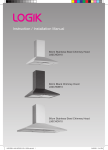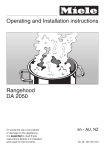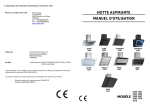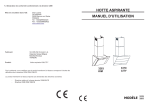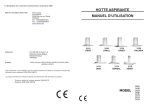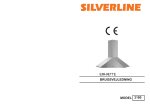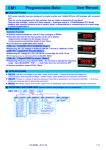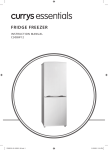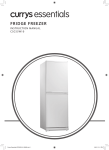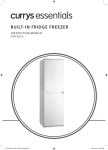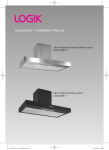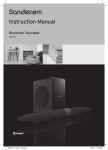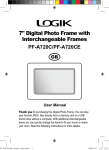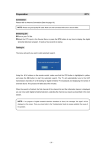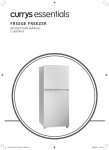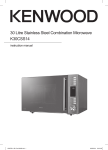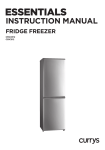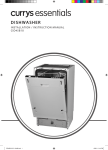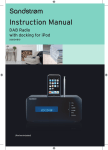Download Instruction / Installation Manual
Transcript
Instruction / Installation Manual 60cm Stainless Steel Chimney Hood L60CHDX10 60cm Black Chimney Hood L60CHDB10 90cm Stainless Steel Chimney Hood L90CHDX10 Contents Unpacking...................................................................................................................................... 4 Product Overview.......................................................................................................................... 5 Control Panel................................................................................................................................. 6 Modes of Operation...................................................................................................................... 6 1. Air Extraction..........................................................................................................................................................6 2. Air Recirculation....................................................................................................................................................6 Operation....................................................................................................................................... 7 To Select the Fan Motor Speed.............................................................................................................................7 Hob Lighting...............................................................................................................................................................7 Cleaning and Maintenance........................................................................................................... 8 Grease Filters...............................................................................................................................................................8 Cleaning the Grease Filters by Hand..................................................................................................................8 Cleaning the Grease Filters in the Dishwasher...............................................................................................9 Carbon Filter Usage..................................................................................................................................................9 Fitting and Replacing the Carbon Filter......................................................................................................... 10 Changing the Lamps............................................................................................................................................. 10 Hints and Tips.............................................................................................................................. 11 If Cooker hood Does Not Operate.................................................................................................................... 11 Technical Specification................................................................................................................ 12 Installation................................................................................................................................... 13 Product Overview................................................................................................................................................... 13 Safety Distance Between Hob and Cooker Hood...................................................................... 14 Connection for Air Extraction..................................................................................................... 15 Mounting the Cooker Hood........................................................................................................ 16 Safety Warnings........................................................................................................................... 18 3 Thank you for purchasing your new Logik Cooker Hood. You must read this manual in order to fully understand how to install and operate it correctly. Read all the safety warnings carefully before use and keep this manual for future reference. Unpacking Remove all packaging from the unit. Retain the packaging. If you dispose of it please do so according to local regulations. The following items are included: Main Unit 10 mm Plastic Wall Plug × 4 (Used for mounting the product on the wall) P.N.: YT 350.1000.02 6 mm plastic wall plug × 2 (Used for mounting chimney connection plate) P.N.: YT 350.1000.01 5.5 x 60 mm YSB Screw × 4 (Used for mounting the product on the wall) P.N.: YT 310.1000.20 3.9 x 22 mm YSB Screw × 2 (Used for mounting chimney connection plate) P.N.: YT 310.1000.16 3.5 x 9.5 mm RYSB Nickel Screw ×4 (Used for mounting chimney) P.N.: YT 310.1000.10 Instruction / Installation Manual 60cm Stainless Steel Chimney Hood L60CHDX10 60cm Black Chimney Hood L60CHDB10 90cm Stainless Steel Chimney Hood L90CHDX10 Chimney Connection Plate × 1 (Used for fixing internal chimney on the wall) P.N.: YT 121.2240.606 Instruction / Installation manual P.N.: YT 610.2250.01-V2 If items are missing or damaged, please contact Partmaster (UK only). Tel: 0844 800 3456 for assistance. 4 Product Overview 1 2 3 4 5 6 1. Recirculation Vents 4. Control Panel 2. Internal Chimney 5. Illumination 3. External Chimney 6. Aluminium Filter 5 Control Panel 1 1. Lamp Switch 2. Motor Speed Selector 2 Modes of Operation There must be adequate ventilation of the room when the cooker hood is used at the same time as appliances burning gas or other fuels. The cooker hood works with 1. Air Extraction The air is drawn in and cleaned by the grease filters and directed outside. The non-return flap supplied with the appliance must be fitted on the exhaust socket of the motor unit. Having a non-return flap fitted in the ducting ensures that air, once ducted to the outside, cannot get back into the room again. The flap is closed when the cooker hood is switched off. When the cooker hood is switched on, the non-return flap opens for the cooking vapours to be ducted away. 2. Air Recirculation The air is drawn in and cleaned first by the grease filters and then by a carbon filter. The cleaned air is then recirculated back into the kitchen through the recirculation vents in the top of the cooker hood chimney. • Carbon filters are available as an optional extra. • Before using the cooker hood in recirculation mode, ensure that the carbon filters are in place. See “Cleaning and Maintenance”. 6 Operation To Select the Fan Motor Speed Your cooker hood has 3 levels of extraction. Depending on the cooking and frying steam, you should run the cooker hood with "1" low, "2" medium or "3" high speed. To run the cooker hood, slide the motor speed selector to the desired extraction speed on the front panel. Slide the Motor speed selector to "0" to turn the unit off. Hob Lighting Your cooker hood has 2 lamps and 1 switch to control the illumination. Slide the Lamp switch to the ON position ( ) to switch the lamps on. • Do not flambé under the cooker hood. • CAUTION: Accessible parts may become hot when used with cooking appliances. 7 Cleaning and Maintenance • Before any cleaning or maintenance work is carried out, disconnect the cooker hood from the mains power supply. Ensure that: –– it is switched off at the isolator, or –– it is switched off at the wall socket and the plug is withdrawn, or –– the fuse from the fused spur connection unit is withdrawn, or –– the mains fuse is disconnected. • The surfaces and controls are susceptible to scratches and abrasions. Please observe the following cleaning instructions. • All external surfaces and controls can be cleaned using a little washing-up liquid applied with a damp soft sponge or cloth. Only use a damp cloth as water could get into the unit and cause damage. • Wipe dry using a soft cloth. Do not use: • cleaning agents containing soda, acids, chlorides or solvents, • abrasive cleaning agents, e.g. powder cleaners or cream cleaners and abrasive sponges, as well as pot scourers or sponges which have been used previously with abrasive cleaning agents as these will damage the surface material. Grease Filters The re-usable metal grease filters in the appliance remove solid particles (grease, dust, etc.) from the kitchen vapours, preventing soiling of the cooker hood. The grease filters should be cleaned regularly (at least every 3-4 weeks) to avoid a build-up of grease. A dirty filter is a fire hazard. 1. To take out the grease filter, press the plastic catch. 2. Pull aluminium filter downwards. To avoid damaging the filters or the hob below, make sure you hold the filters securely at all times when handling them. 1. 2. Cleaning the Grease Filters by Hand • Clean the filters with a soft nylon brush in a mild solution of hot water and a little washing-up liquid. Do not use “neat” washing up liquid. Do not use: • cleaning agents containing descaling agents, • powder cleaners, cream cleaners or abrasive all-purpose cleaners. • Oven cleaners. 8 Cleaning the Grease Filters in the Dishwasher • Place the filters as upright as possible in the lower basket, with the short sides upright, and wash in a 65°C programme, ensuring the spray arm is not obstructed. • Use a mild dishwasher detergent. Depending on the cleaning agent used, cleaning the filters in a dishwasher can cause permanent discolouration to the surface. However, this will not affect the functioning of the filters in any way. • After cleaning, leave the filters to dry on an absorbent surface before replacing them. • When removing the filters for cleaning, also clean off any residues of oil or fat from the now accessible housing to prevent the risk of these catching fire. When putting the grease filters back in position, ensure that the locking clips are facing down towards the hob. • If a grease filter is inadvertently replaced upside down, insert a small screwdriver blade into the slot shown to disengage the clip. Carbon Filter Usage Your product is compatible with one type of carbon filter. • Before installing or replacing the carbon filters, you should switch off and disconnect the electricity supply. • The carbon filters should never be washed. • The grease filter should be installed on the product even when carbon filters are not being used. Do not use your product without the grease filter. 9 Fitting and Replacing the Carbon Filter • It is necessary to install 2 carbon filters to your product. • To attach the carbon filter, place your filter on the connection channels on the motor and turn the left hand filter clockwise and the right hand filter anti-clockwise. • In order to remove filters, turn the left hand filter anti-clockwise and the right hand filter clockwise. • Replace the carbon filters when they no longer absorb kitchen odours effectively. They should, however, be replaced at least every 6 months to prevent a risk of fire. • Used carbon filters can be disposed of with the normal household waste. Changing the Lamps 1.Disconnect the electricity supply. 2.Remove the aluminium grease filter. 3.Replace with a 25W 240V SES (E14) candle lamp in each holder. 10 Hints and Tips Problem Cooker hood does not operate Solution • Check Electric connection. (The supply voltage should be 220-240 V. The cooker hood must be connected to an earthed socket.) • Check motor speed selector. (Motor speed selector should be in position 1,2, or 3.) Lamp does not light • Check Electric connection. (The supply voltage should be 220-240 V. The cooker hood must be connected to an earthed socket.) • Check lamp switch. (Lamp switch should be in the on position.) • Check lamps have not blown. • Check aluminium filter. (Aluminium grease filter should be washed once a month under normal conditions.) Air suction of cooker hood is weak • Check air outlet chimney. (Air outlet chimney should be open.) • Check carbon filter. (If operating with carbon filters, the carbon filters should be replaced every 3 months.) If Cooker hood Does Not Operate Be sure that the plug is connected to the socket and the fuse in the installation is in good condition, check your cooker hood according to the above table. If the problem continues, contact an authorised service agent. 11 Technical Specification Model no. L60CHDB10 / L60CHDX10 / L90CHDX10 Extraction Rate (m3/h) Voltage (V) 250 220 – 240 ~ Frequency (Hz) 50 Total Power (W) 160 Lamp Features and specifications are subject to change without notice. 12 2 × 25 W Installation Product Overview 1 2 3 1. Chimney Connection Plate 2. Internal Chimney 3. External Chimney All dimensions shown are in mm. 13 Safety Distance Between Hob and Cooker Hood When planning the installation height of your cooker hood, the minimum safe distance between the top of a cooker or hob and the bottom of the cooker hood are as follows, unless a greater distance is specified by the manufacturer of your cooking appliance: 650 mm — above electric hobs and cookers 750 mm — above gas hobs and cookers • When deciding on the safe distance between the hob and cooker hood, please note that a distance greater than 650 mm above electric cookers/hobs may be preferable to give more working space under the hood. • Account should also be taken of the height of the person who will be using the hood most often. The person should have sufficient space to work comfortably at the hob, and also be able to reach the hood controls with ease. • Please be aware that if positioned too high, extraction will be inefficient. • If you want the top of the cooker hood telescopic extension piece to be mounted flush with the ceiling, make sure there is adequate space below the appliance for working. See maximum/minimum appliance height. 14 Connection for Air Extraction • To avoid the danger of toxic fumes, please observe the Safety Warnings. • This is especially crucial when using the cooker hood at the same time as another heating appliance which relies on air from the same room. • The cooker hood should be installed according to local and national building regulations. Seek approval from the building inspector where necessary. Only use smooth pipes or flexible hoses made from non-flammable materials for the extraction ducting. Do not use ducting designed for use with tumble dryers. To achieve the greatest possible air extraction with the lowest noise level, please note the following: • To ensure efficient air extraction, the diameter of the exhaust ducting should not be less than 125 mm. • If flat ducting is being used, the cross-sectional area must not be smaller than the cross sectional area of the exhaust connection. • All ducting, pipework and fittings must be of non-flammable materials. • The exhaust ducting should be as short and straight as possible. • Only use wide radius bends. • The exhaust ducting should not be kinked or compressed. • Ensure that all connections are strong and airtight. • Where ducting is horizontal, it must be laid to slope away at least 1 cm per metre. This is to ensure that condensation cannot drain back into the cooker hood. • If the exhaust air is to be ducted into the open air, the installation of a telescopic wall vent or roof vent is recommended. If the exhaust ducting is to run through rooms, ceiling space etc. where there may be great variations in temperature between the different areas, the problem of condensation will need to be addressed. The exhaust ducting will need to be suitably insulated. 15 Mounting the Cooker Hood • We recommend that a qualified technician is consulted prior to the fitting of this appliance. • Each installation is different and these instructions should be used as a guide only. • Air must not be discharged into a flue that is used for exhausting fumes from appliances burning gas or other fuels. 1. A 125mm hole will need to be provided for the aluminium flexible hose (not supplied) to duct the extracted air to the outside. For recirculation operation, a competent person can follow the instructions below. If you are in any doubt, we recommend you consult a qualified technician. 2. Ensure there is an available switched electrical socket adjacent to the hood to power the appliance. If this is not available, do not use extension leads. We recommend you consult a qualified electrician prior to commencing any work. 3. Offer the appliance to the wall surface ensuring the minimum dimensions are met (650 mm for electric hobs and 750 mm for gas) and ensure the appliance is level. Mark the two keyhole points on the top of the hood. Using a 10 mm drill bit and ensuring there is no pipe work or wires buried in the wall drill the two holes to a sufficient depth to insert two of the 10 mm wall fixings flush into the wall. A C ELECTRICITY min. 650 150 183 240 D GAS min. 750 For L60CHDX10 & L60CHDB10 16 150 A B B 183 C ELECTRICITY D 600 min. 650 GAS min. 750 For L90CHDX10 4. Using two of the 5.5 x 60 mm YSB screws, screw into the wall fixings leaving a 5mm gap between the bottom of the screw head and the wall. Hang the appliance on the two screws and ensure it is level. 5. Locate the two safety holes on the inside of the appliance and mark these on the wall surface. Temporarily place the internal and external chimney parts on the top of the hood and mark the position of the chimney connection plate holes on the wall surface. 6. Remove the chimney sections and hood from the wall. 7. Ensuring there is no pipe work or wires buried in the wall, use a 10mm drill bit and drill the two safety holes to a sufficient depth to insert the two remaining wall fixings flush into the wall. Using a 6 mm drill bit, drill the two holes for the chimney connection plate and insert the two 6 mm wall fixings flush to the wall. 8. Using the two 3.9 x 22 mm YSB screws, secure the chimney connection plate to the wall. Tighten the screws fully. safety hole For L60CHDX10 & L60CHDB10 safety hole For L90CHDX10 9. Refit the hood to the wall and insert the two safety screws into the safety holes. Ensure the unit is level and fully tighten the screws. Fully tighten the two keyhole screws. 10. Fit the external chimney section to the hood using two of the 3.5 x 9.5 mm screws. 11. Insert the internal chimney section into the external section and using the two remaining 3.5 x 9.5mm screws secure to the chimney mounting plate. 12. Ensure all protective coverings have been removed from the metal surfaces prior to use. 13. Follow the operation instructions in this manual for safe operation of this appliance. 17 Safety Warnings • This appliance complies with all relevant local and national safety requirements. Inappropriate use can, however, lead to personal injury and damage to property. • To avoid the risk of accidents and damage to the appliance, please read these instructions carefully before using it for the first time. They contain important information on the safety, installation, use and maintenance of the appliance. • Keep these instructions in a safe place and ensure that all users are familiar with the contents. Pass them on to any future owner of the appliance. Correct Application • This appliance is not designed for commercial use. It is intended for use in domestic households. • It must only be used as a domestic appliance to extract vapours and remove odours from cooking. • Any other usage is not supported by the manufacturer and could be dangerous. The manufacturer cannot be held liable for damage resulting from incorrect or improper use or operation of the appliance. • This appliance is not intended for use by persons (including children) with reduced physical, sensory or mental capabilities, or lack of experience or knowledge, unless they have been given supervision or instruction concerning its use by a person responsible for their safety. • Do not flambé under the cooker hood. Correct Use • Never use an open flame beneath the cooker hood. To avoid the danger of fire, do not flambé or grill over an open flame under the cooker hood. • When switched on, the cooker hood could draw flames into the filter. Fat particles drawn into the cooker hood present a fire hazard. When using the cooker hood over a gas hob, ensure that any burners in use are always covered by a pan. Switch the cooking zone off when a pan is removed, even for a short time. • Regulate the flame so that it does not burn up the sides of the pan. • Do not allow the pans to overheat excessively (e.g. when using a wok). • The cooker hood can become damaged when exposed to excessive heat. • A lways switch the cooker hood on when a cooking zone is in use, otherwise condensation may collect in the hood, which could cause corrosion. • W hen cooking with oil or fat, chip pans and deep fat fryers etc, do not leave the pans unattended. Never leave an open grill unattended when grilling. Overheated oil and fat can ignite and could set the cooker hood on fire. • D o not use the cooker hood without the filters in place. This way you will avoid the risk of grease and dirt getting into the appliance and hindering its smooth operation. • Accessible parts may become hot when used with cooking appliances. • T he filters should be regularly cleaned or changed as appropriate. Saturated filters are a fire hazard. See "Cleaning and Maintenance". • If the supplied mains cable is damaged, it must be replaced by the manufacturer, its service agent or similarly qualified persons in order to avoid a hazard. • T he cooker hood can get very hot during cooking due to heat rising from the hob. Do not touch the housing or the grease filters until the cooker hood has cooled down. Safety with Children • D o not use a steam-cleaner to clean this appliance. Steam could reach the electrical components and cause a short circuit. • This appliance is only intended for use by adults who have read these instructions. • This appliance is not a toy! To avoid the risk of injury, keep children well away and do not allow them to play with it or to use the controls. They will not understand the potential dangers posed by it. They should be supervised whenever you are working in the kitchen. • Older children may use the cooker hood only when its operation has been clearly explained to them and they are able to use it safely, recognising the dangers of misuse. 18 Technical safety • Before installation, check the cooker hood for visible signs of damage. Under no circumstances should you use a damaged appliance. It could be dangerous. • Before connecting the appliance to the mains supply, make sure that the voltage and frequency details given on the data plate correspond with the on-site electricity supply, otherwise the appliance could be damaged. Consult a qualified electrician if in any doubt. • The electrical safety of this appliance can only be guaranteed when continuity is complete between the appliance and an effective earthing system which complies with current local and national safety regulations. It is most important that this basic safety requirement is present and tested regularly, and where there is any doubt, the household wiring system should be inspected by a qualified electrician. The manufacturer cannot be held liable for the consequences of an inadequate earthing system (e.g. electric shock). Using at the same time as other heating appliances that depend on the air from the same room. WARNING: Danger of toxic fumes. • For safety reasons, this appliance may only be used when it has been fully installed. • Only open the housing as described in the instructions. Under no circumstances should any other parts of the housing be opened. Tampering with electrical connections or components and mechanical parts is highly dangerous to the user, and can cause operational faults. • Installation, maintenance and repairs may only be carried out by an authorised person in accordance with current national and local safety regulations. Repairs and other work by unqualified persons could be dangerous. The manufacturer cannot be held liable for unauthorised work. • Faulty components must only be replaced by genuine original parts. The manufacturer can only guarantee the safety of the appliance when suitable replacement parts are used. • During installation, maintenance and repair work, the appliance must be disconnected from the mains electricity supply. It is only completely isolated from the electricity supply when: a) it is switched off at the isolator, or b) the mains fuse is disconnected, or c) it is switched off at the wall socket and the plug withdrawn, or d) the fuse to the fused spur connection unit is withdrawn. • G reat care should be taken when using the cooker hood at the same time and in the same room or area of the house as another heating appliance which depends on the air in the room. Such appliances include gas, oil, wood or coal-fired boilers and heaters, continuous flow or other water heaters, gas hobs, cookers or ovens which draw air in from the room and duct exhaust gases out through a chimney or extraction ducting. • When used in extraction mode, the appliance draws air in from the room in which it is installed and from neighbouring rooms. • If there is insufficient air, an underpressure will occur. The heating appliance may be starved of oxygen, impairing combustion. • Harmful gases could be drawn out of the chimney or extraction ducting back into the room, with potentially fatal consequences. • In order to ensure safe operation, and to prevent gases given off by the heating appliances from being drawn back into the room when the cooker hood and the heater are in operation simultaneously, an underpressure of 0.04 mbar (4 pa) is the maximum permissible in the room. • Do not connect the appliance to the mains electricity supply by a multi-socket unit or an extension lead. These do not guarantee the required safety of the appliance (e.g. danger of overheating). • This appliance may only be used in mobile installations if a risk assessment of the installation has been carried out by a suitably qualified engineer. • In areas which may be subject to infestation by cockroaches or other vermin, pay particular attention to keeping the appliance and its surroundings in a clean condition at all times. Any damage which may be caused by cockroaches or other vermin will not be covered by the guarantee. 19 Correct Installation • Refer to the cooker or hob manufacturer's instructions as to whether a cooker hood may be operated above the cooker/hob. • T he minimum safe distances between the top of the cooker or hob and the bottom of the cooker hood given in the Installation section of this booklet must be maintained, unless the hob/ cooker manufacturer states that a greater safe distance is required. • Ventilation can be maintained by air inlets which must not be blocked, in windows, doors and outside wall vents, or by other technical measures, such as ensuring that the cooker hood can only be switched on when the heating appliance is switched off or vice versa. A ventilation brick alone is not generally sufficient to ensure safe ventilation. The overall ventilation condition of the dwelling must be taken into account. If in any doubt, the advice of a competent builder or, for gas, a qualified gas fitter (Gas Safe registered in the UK) must be sought. • One of the following technical measures may be necessary to ensure safe operation. • If the only way of ensuring adequate ventilation is via an open window, a window contact switch should be fitted to ensure that the cooker hood can only operate when the window is opened sufficiently. A window contact switch kit is available from good builders' merchants. Take care when ventilating the room through an open window that ventilation is not impaired by a closed blind or curtain. If in any doubt , the advice of a qualified builder, gas fitter (Gas Safe registered in the UK) or electrician must be sought. If the hood is being operated in recirculation mode, the above restrictions do not apply. 20 • If more than one appliance is fitted beneath the cooker hood, and they have different minimum safe distances to the cooker hood, select the greater distance. • S afety regulations prohibit the fitting of a cooker hood over solid fuel stoves. • A ll ducting, pipework and fittings must be of nonflammable material. These can be obtained from builders' merchants. • T he appliance must not be connected to a chimney or vent flue which is in use. Neither should it be connected to ducting which ventilates rooms with fireplaces. • I f exhaust air is to be extracted into a chimney or ventilation duct no longer used for other purposes, seek professional advice. Accessories • Only use genuine original spare parts and accessories with this appliance. The manufacturer cannot be held liable for damage caused by non-compliance with these Warning and Safety instructions. If you require a replacement for any of the items listed below, please quote their corresponding part numbers: Replacement Part Part Number 10 mm Plastic Wall Plug YT 350.1000.02 6 mm Plastic Wall Plug YT 350.1000.01 5.5 × 60 mm YSB Screw YT 310.1000.20 3.9 × 22 mm YSB Screw YT 310.1000.16 3.5 × 9.5 mm RYSB Nickel Screw YT 310.1000.10 Chimney Connection Plate YT 121.2240.606 Carbon Filters YT 971.1190.01 Grease Filters (L60CHDB10 & L60CHDX10) YT 142.2240.01 Grease Filters (L90CHDX10) YT 142.2240.03 Visit Partmaster.co.uk today for the easiest way to buy electrical spares and accessories. With over 1 million spares and accessories available we can deliver direct to your door the very next day. Visit www.partmaster.co.uk or call 0844 800 3456 (UK customers only). This symbol on the product or in the instructions means that your electrical and electronic equipment should be disposed at the end of its life separately from your household waste. There are separate collection systems for recycling in the EU. For more information, please contact the local authority or your retailer where you purchased the product. DSG Retail Ltd. • Maylands Avenue • Hemel Hempstead Herts • HP2 7TG • England (P.N.: YT 610.2250.01-V2)
























